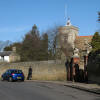|
Hidden East Anglia: Landscape Legends of Eastern England
|
||
|
|
The sunken church
Oby is a tiny hamlet that forms part of the parish of Ashby with Oby, in the Norfolk Broads just north of Acle. 'A General History of the County of Norfolk', published in 1829, says that "the church is on the road side leading from Thurne to Yarmouth". But by the time of the First World War, the folklore writer W. B. Gerish recorded that "the parish church here has vanished and is said to have sunk in the ground". It's possible that this is just a fragment of a tale similar to that of Dilham's 'sunken church', further north in the Broadland.
Source: W. B. Gerish: 'Norfolk Legends' (unpublished notes, c.1914.)
White Woman Lane
This lane runs between Spixworth Road on the west, and the B1150 North Walsham Road on the east, and is haunted by one of the ubiquitous 'white lady' ghosts of British folklore. The usual story recounted is that the woman was the daughter of the local squire, in love with one of his coachmen. She lived in the manor house on one side of the road, while he lived in a lodge on the other side, and for some reason, her ghost has been seen at twilight crossing and recrossing the road.1 The problem with this is that there has never been either manor or lodge in White Woman Lane.
However, the lane also runs into the neighbouring parish of Sprowston, which has a more coherent tradition. In this, the apparition is of a young woman who married the lord of Catton Old Hall - built in 1632, in Lodge Lane just beyond the western end of White Woman Lane (TG235128). She was wed at the church in Sprowston (TG250125), but died soon after at the hands of her wicked husband. Thus her spirit, clad in white, walks from the Hall, along the lane, along a path through the grounds of Oak Lodge, and so to the church.2 Old maps mark the road as 'White Woman's Lane', the name also given to a haunted lane in Eyke, in Suffolk.
Sources: 1. Joan Forman: 'Haunted East Anglia' (Fontana, 1976), p.38-9. 2. Audrey Jamieson: 'Some of Sprowston's History' (Sprowston Heritage, 2007).
The old manor house mentioned above (TG229123) is supposed to have had a subterranean passage leading from it, but where it ran to isn't stated.
Source: Walter Rye: 'History of the Parish of Catton' (Roberts & Co, 1919), p.234.
Cromwell's men
A slight legend here tells that some of Oliver Cromwell's men are buried in the churchyard at St. Peter and St. Paul's (TG136285) - though why they're here, and exactly where, isn't known.
Source: 'Off the Beaten Track' - Blickling to Cawston cycle tour leaflet - Broadland District Council.
The bathing eagles
Source: 'Eastern Daily Press', September 9th 1939.
The running stone
A stone here is said to run across the road when it hears the Caldecote church bells strike midnight. But of the church of St. Mary the Virgin (TF744034), near Caldecote Farm, virtually nothing now remains.
Secret tunnel
"According to local residents, a 'secret tunnel' is said to go from Oxnead Hall, Norfolk, to the parish church" (TG229240).
Source: From Radio Norfolk 3/1/82, noted in 'Lantern' 36, p.5. |
|
